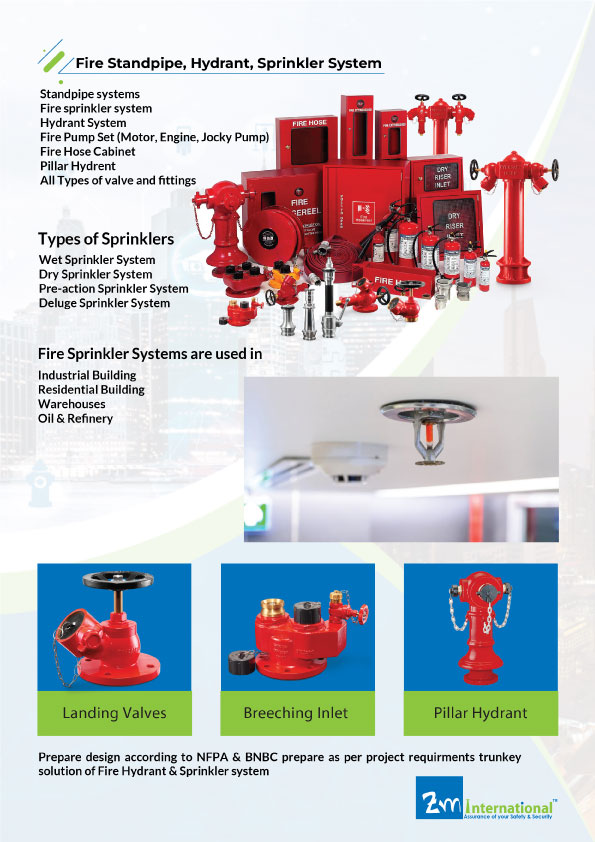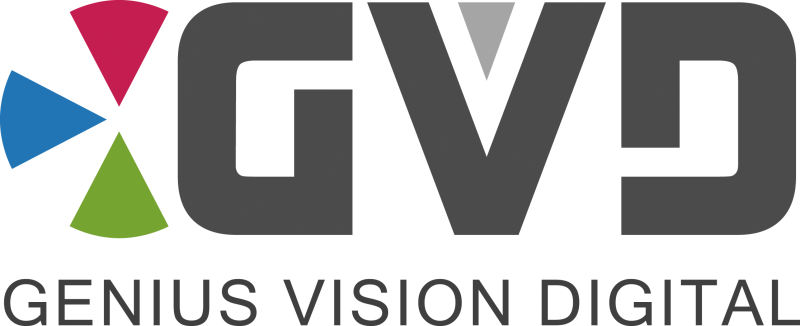+88 0192 0098535 : info@zmintl.com

















FIRE SPRINKLER & HYDRANT SYSTEM
Fire Hydrant & Sprinkler Systems are essential components of a building's fire suppression strategy, designed to control and extinguish fires in their early stages. These systems ensure that water is readily available to combat fires, providing crucial protection for both occupants and property. At ZM International, we offer comprehensive, high-quality fire hydrant and sprinkler systems tailored to meet the safety needs of various environments, from residential complexes to industrial facilities, all in compliance with NFPA and BNBC standards.
1. Fire Hydrant Systems:
A fire hydrant system provides a network of pipes delivering water at high pressure to strategic points around a building or site. These hydrants are accessible for use by firefighters or trained personnel to quickly respond to a fire emergency.
1.1. Types of Fire Hydrant Systems:
External (Yard) Hydrant Systems: Installed outside buildings, these hydrants are placed at accessible locations around a facility to ensure easy access for firefighting teams.
Internal Hydrant Systems (Wet Riser Systems): Installed within buildings, these systems provide water at high pressure through internal risers and hoses, enabling firefighting teams to access water directly from inside the building.
1.2. Components of Fire Hydrant Systems:
Hydrant Valves (Single or Double Outlet): Valves located at each hydrant point to control water flow during firefighting.
Fire Hoses & Nozzles: Hoses connected to the hydrant valves, equipped with nozzles to direct high-pressure water to the fire.
Fire Hose Reels: Mounted on walls for easy access, fire hose reels allow for quick deployment of hoses in emergency situations.
Hydrant Booster Pumps: Pumps that ensure a consistent and adequate supply of water at high pressure, crucial for large or high-rise buildings.
Water Storage Tanks: Ensure that there is a ready and sufficient water supply, either stored on-site or drawn from external water mains.
1.3. Benefits of Fire Hydrant Systems:
High-Pressure Water Supply: Provides an immediate and reliable source of high-pressure water for firefighting teams.
Coverage for Large Areas: Suitable for large complexes, industrial sites, or high-rise buildings where a quick response is crucial.
Manual Control: Fire hydrant systems allow firefighters or trained personnel to control water flow directly at the scene, providing greater flexibility during emergencies.
2. Fire Sprinkler Systems:
Fire sprinkler systems are automatic fire suppression systems that activate in response to heat generated by a fire. These systems are widely used to provide 24/7 fire protection in a wide variety of environments, minimizing fire damage by controlling or extinguishing fires before they spread.
2.1. Types of Fire Sprinkler Systems:
Wet Pipe Sprinkler Systems: The most common type, these systems have water stored in the pipes and release it immediately when the sprinkler head detects heat. Suitable for environments that maintain above-freezing temperatures, such as offices, residential buildings, and retail spaces.
Dry Pipe Sprinkler Systems: These systems are filled with pressurized air or nitrogen, with water released only when the sprinkler head activates. Ideal for cold environments where pipes may freeze, such as warehouses, garages, or industrial facilities.
Deluge Sprinkler Systems: Designed for high-hazard areas, these systems have open sprinkler heads that release a large volume of water over a wide area when activated by a separate fire detection system. Used in places with high fire risks like chemical plants or aircraft hangars.
Pre-Action Sprinkler Systems: A combination of wet and dry systems, pre-action systems require two triggers—a fire detection system and heat activation—to release water. Suitable for areas where accidental water discharge would cause significant damage, such as data centers, museums, or archives.
2.2. Sprinkler System Components:
Sprinkler Heads: Heat-sensitive heads that release water when a specific temperature threshold is reached. Available in various types like pendant, upright, or sidewall designs.
Control Valves: Manually or automatically operated valves that control water flow to the sprinkler system.
Flow Switches: Detect water movement within the pipes and signal the control panel when the system is activated.
Pressure Gauges: Monitor the water pressure within the system to ensure optimal performance.
Sprinkler Pumps: Ensure that water is delivered at the necessary pressure, particularly in large or high-rise buildings.
Water Supply Tanks: Dedicated storage tanks to provide sufficient water for fire suppression, ensuring availability in the event of a fire.
2.3. Benefits of Fire Sprinkler Systems:
Immediate Response: Sprinklers activate automatically at the early stages of a fire, controlling or extinguishing the flames before they can spread.
Localized Activation: Only the sprinkler heads directly affected by heat from the fire are activated, minimizing water damage to the surrounding areas.
24/7 Protection: Provides continuous fire protection, whether the building is occupied or not.
Integration with Fire Alarms: Many systems can be integrated with fire alarm systems, triggering building-wide alarms when the sprinklers activate.
3. Design & Installation Services:
At ZM International, we offer customized design, installation, and maintenance of fire hydrant and sprinkler systems to ensure optimal performance and compliance with fire safety standards.
3.1. System Design:
Our team of experts assesses your building layout, fire risks, and local regulations to design a system that provides maximum coverage and efficiency.
We use advanced software tools to create detailed designs, ensuring the system meets NFPA and BNBC guidelines.
3.2. Installation:
We handle all aspects of system installation, from laying out the network of pipes to positioning hydrants and sprinkler heads for optimal coverage.
Our certified technicians ensure that all components are installed according to the highest safety standards, ensuring the system operates effectively in case of fire.
3.3. Testing & Commissioning:
Once installed, we conduct rigorous testing to ensure the system functions as intended. This includes pressure tests, flow rate checks, and activation of sprinkler heads and hydrants.
We also train your staff on system operation, including how to use hydrants and maintain system components.
3.4. Maintenance Services:
Regular inspection and maintenance are essential for ensuring that fire hydrant and sprinkler systems remain in top working condition.
We provide scheduled maintenance services, including pressure checks, system flushes, and replacement of faulty or outdated components.
4. Integration with Other Systems:
Fire hydrant and sprinkler systems can be integrated with other building safety systems for a more comprehensive fire protection strategy:
4.1. Integration with Fire Alarms:
When the sprinkler system is activated, it can be linked to the fire alarm system to trigger building-wide alerts and evacuations.
Fire hydrants can also be integrated with monitoring systems to alert security personnel when they are in use.
4.2. Integration with Building Management Systems (BMS):
The system can be connected to a BMS to allow remote monitoring and control, ensuring that building managers can quickly respond to fire emergencies.
4.3. Water Supply Management:
Our systems are designed to integrate with city water supplies or dedicated water storage tanks, ensuring continuous availability of water even during high-demand periods.
At ZM International, our Fire Hydrant & Sprinkler Systems are designed to provide maximum protection for your building and its occupants, ensuring rapid response to fire emergencies and minimizing fire-related damage. From initial design and installation to ongoing maintenance and compliance, we offer end-to-end solutions to keep your property safe from fire hazards.






